2018 was an interesting year for Facebook. You could say it’s the year they woke up and realized people were actually paying attention… but it’s not clear they’re awake yet.
Kicking off with the Cambridge Analytica scandal and continuing with court appearances, dropping stock, the departure of Instagram’s founders and countless algorithm updates, Facebook has once again proven itself to be the most frustratingly unpredictable platform out there.
And yet, it remains the most valuable source of targeted traffic for affiliate marketers.
Although many alternatives exist and cross-platform strategies have grown in popularity, there’s one number that ought to bring you back to reality if you’ve been considering ditching Zuck’s pet project:
88%
That’s the percentage of active internet users between age 18-29 who are on Facebook (as of Q3 2018). It’s similarly high for the 30-49 bracket (84%).
No other platform can give you targeted access to 2.27 billion daily active users (DAU) like Facebook can. Not even close.
That’s why affiliates continue to invest thousands, even millions in ad spend on the platform. And if you’re one of them, doesn’t it stand to reason that you should also invest time in learning the non-tactical stuff?
In an industry defined by competitive advantages, consistently predicting changes – and proactively preparing for them – is too often overlooked.
How to read this article
This article aims to give you a thorough overview of Facebook’s biggest changes in 2018. Most information has been pulled directly from Facebook, with some excellent insights from 3rd party reports and news outlets.
The intention is to aggregate and deliver all the relevant hard facts we could find about Facebook over the past year. Each of us has a different approach to Facebook, and thus our conclusions will be different.
Summary of Major Changes in 2018
A lot happened. A LOT. We’ll focus on just the events that affect the advertising, data and tracking side of things. Let’s start from the beginning…
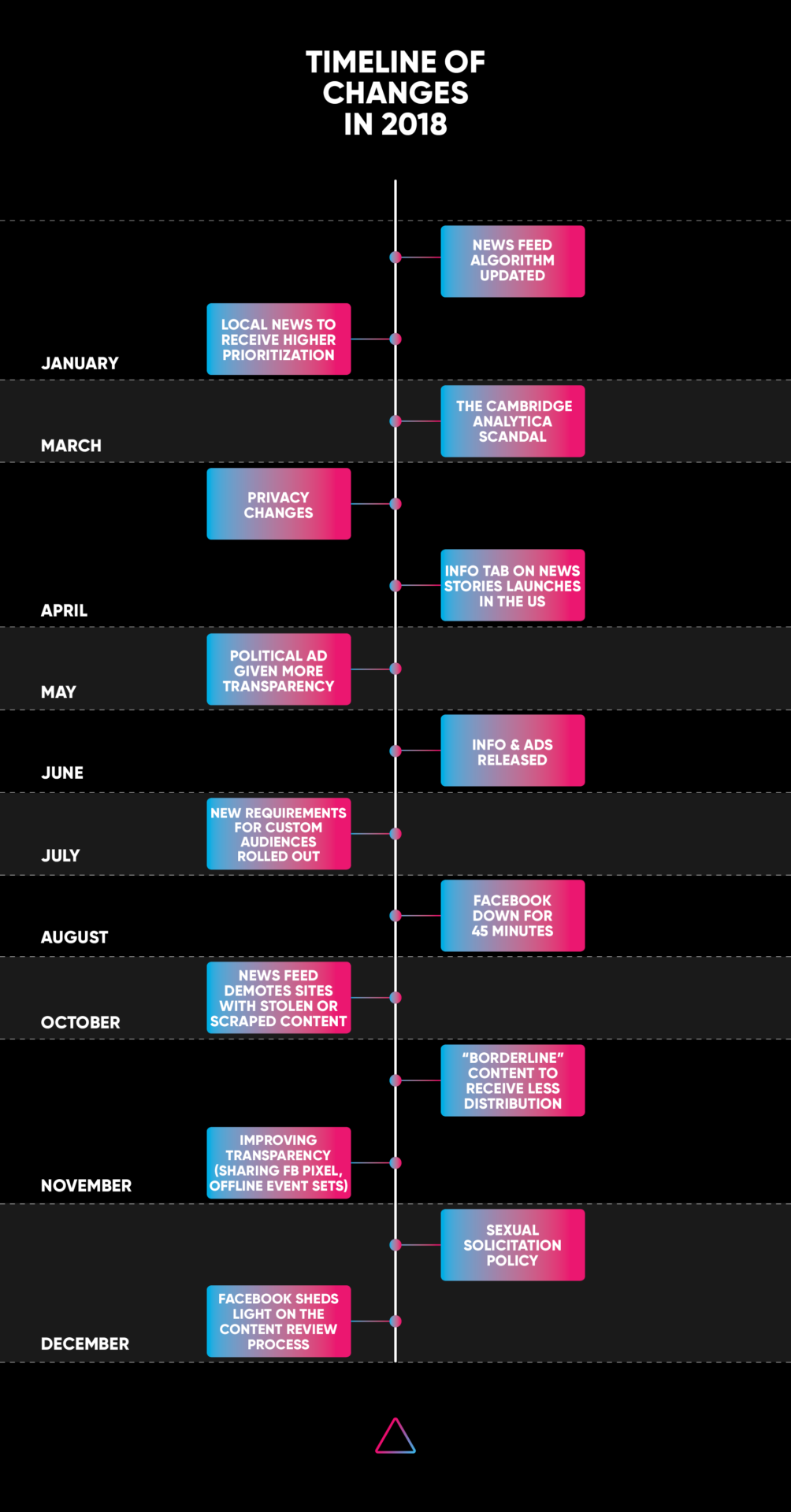
January: News Feed Update
As part of the response to fallout from the 2016 US elections and Brexit vote, the News Feed Algorithm received a major update to prioritize “meaningful interactions between people”.
From Facebook
“…we will prioritize posts that spark conversations and meaningful interactions between people. To do this, we will predict which posts you might want to interact with your friends about, and show these posts higher in feed. These are posts that inspire back-and-forth discussion in the comments and posts that you might want to share and react to – whether that’s a post from a friend seeking advice, a friend asking for recommendations for a trip, or a news article or video prompting lots of discussion.”
As a result, Facebook saw lower engagement overall, especially when compared to Instagram. The top 500 brands on Facebook saw a 50% decrease in engagement compared to 2017. However, Facebook expected this; it’s part of their “quality over quantity” strategy.
January: Local News Receives Higher Prioritization
Local news sources are now seen more frequently, at the cost of lower visibility for broader publications.
From Facebook:
“In 2018, we will prioritize:
News from publications that the community rates as trustworthy
News that people find informative
News that is relevant to people’s local community”
The potential reach of news sources was impacted this time, and is now dependent these 3 primary factors. Facebook stated that “you’ll see less public content, including news, video, and posts from brands. After this change, we expect news to make up roughly 4% of News Feed — down from roughly 5% today.”
This opens up 3 questions:
1. How does Facebook determine if a news source is “trustworthy”?
A: It’s subjective; they send out surveys to “diverse and representative samples” to gauge whether or not they recognize and trust various sources.
2. How does Facebook determine if a news source is “informative”?
A: This is also subjective; they actually began surveying users in August 2016, asking them to rate how informative an article is from 1-5. This rating is aggregated and those receiving positive scores (above 2.5) are promoted while scores lower than 2.5 are demoted.
3. How does Facebook determine if a news source is “local”?
A: This is less clear and a longer process. The biggest step taken comes in a new feature: “Today In”, which features local news updates for specific areas. Users self-identify as living in a particular local area. Facebook began testing with 6 cities in January 2018 and the feature has now rolled out worldwide.
March: The Cambridge Analytica Scandal
Public trust in Facebook plummeted overnight with the release of whistleblower Christopher Wylie’s testimony.
We don’t need to go into much detail on this one. As you all know, the CA scandal uprooted already-shaky confidence – not only in Facebook, but in all social networks and essentially any entity that houses data. It preceded GDPR by about 2 months and attracted extreme levels of scrutiny from Facebook users.
The fallout from this will be felt for years to come and most major changes will likely be traceable to aspects of this PR nightmare.
P.S. Facebook’s punishment was announced in October: a crushing £500k fine. (They generate about 90 times that amount every day.)
April: Privacy changes
Hot on the heels of the CA scandal, Facebook quickly implemented a series of privacy changes. Here’s an overview:
- Events API: This was how CA got much of their data. Heavy restrictions put an end to the practice of pulling friends data from apps and other clever tricks.
- Groups API: Apps can no longer pull group member lists and all 3rd-party apps need approval from both Facebook and a group admin to access private content.
- Pages API: Now also on an approval basis, as it let app devs “access too much data”.
- Facebook login: Facebook now requires approval for apps that request information including check-ins, likes, posts, events and groups. It also requires apps to agree to strict requirements before accessing this data.
- Instagram platform API: Originally scheduled for deprecation later in the year, CA hastened its shutdown.
- Searching by email or phone number removed: You used to be able to search via email or phone number to find someone’s profile. Now you can’t.
- Call and text history: Facebook used to store logs of your call/text history indefinitely (if you opted in via Messenger or Facebook Lite). Now those logs are automatically deleted after a year.
- Partner Categories shut down: 3rd parties like Experian and Acxiom were previously able to offer their data insights as targeting options within Facebook. Gone.
- App controls: Users started receiving links at the top of their feed that allowed them to review the information apps have stored about them.
This meant that a lot of the techniques marketers used to gather data without consumers’ consent were blocked or severely limited. Perhaps the biggest change was the removal of Partner Categories.
April: Info tab on News Stories launches in the US
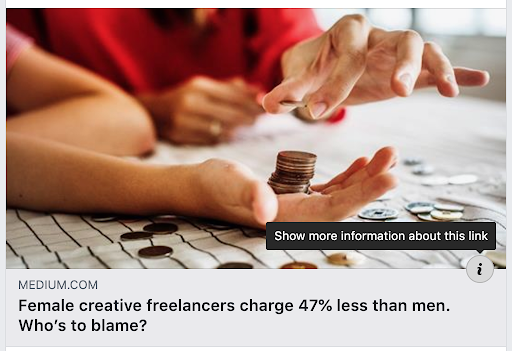
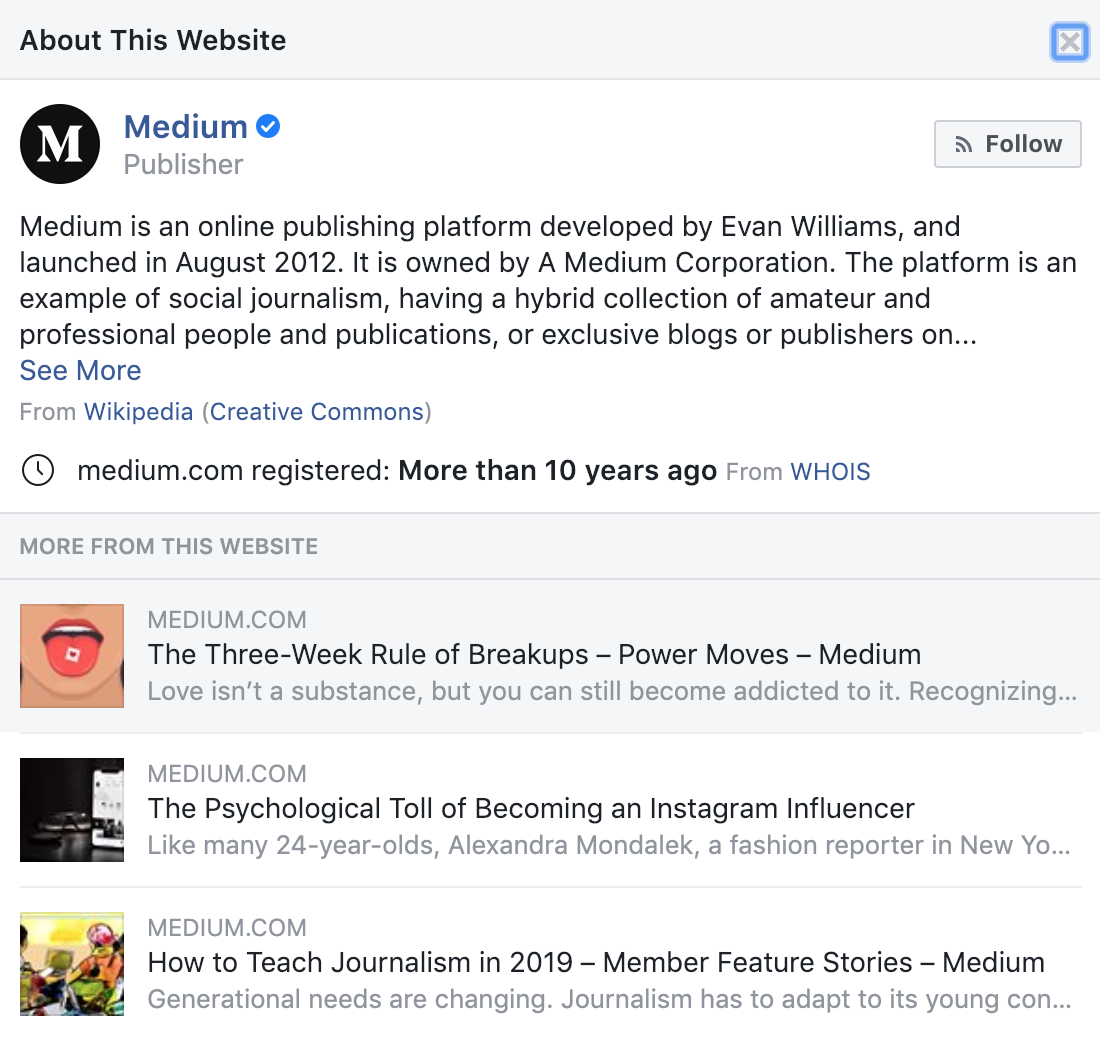
Facebook had already been testing a tab that gave context to news articles, but they rolled it out across the country in April. The tab included:
- The publisher’s Wikipedia entry
- Related articles on the same topic
- Information about how many times the article has been shared on Facebook
- Where it has been shared
- An option to follow the publisher’s page
With the full rollout, they added two more tabs:
- More From This Publisher, which provides a quick snapshot of recent stories posted by the publisher
- Shared By Friends, which shows which of your friends have shared the article
As of January 2019, this feature has now rolled out worldwide.
May: Political ads given more transparency
All political ads in the US started including a “Paid for by” disclosure and were archived for public access.
As a result, all political ads (and ads focusing on issues of national importance) can easily be searched and found at the Facebook Ad Archive. This feature is currently only available in the US, the UK and Brazil.
June: Info & Ads released
Facebook introduced a new tab: Info & Ads. This section allows you to see all active ads being run by all pages (no longer just political).
Overnight, spying and transparency reached a new level – although frequency or post engagement isn’t shown on the Info & Ads tab, you can easily access all advertisements run by your competitors in one place.
Although there was a trick to hide this (changing your page to a Video Page), this no longer appears to work.
July: New requirements for custom audiences rolled out
A number of updates affected targeting and custom audiences, including:
-
- Showing people the origin of the audience information: When uploading a custom audience, you now must specify whether the data came directly from customers, through a 3rd party or both.
- “Why am I seeing this?” rolled out: This new feature gives anyone served an ad the option to review exactly why they were targeted, including the source of the advertiser’s data.
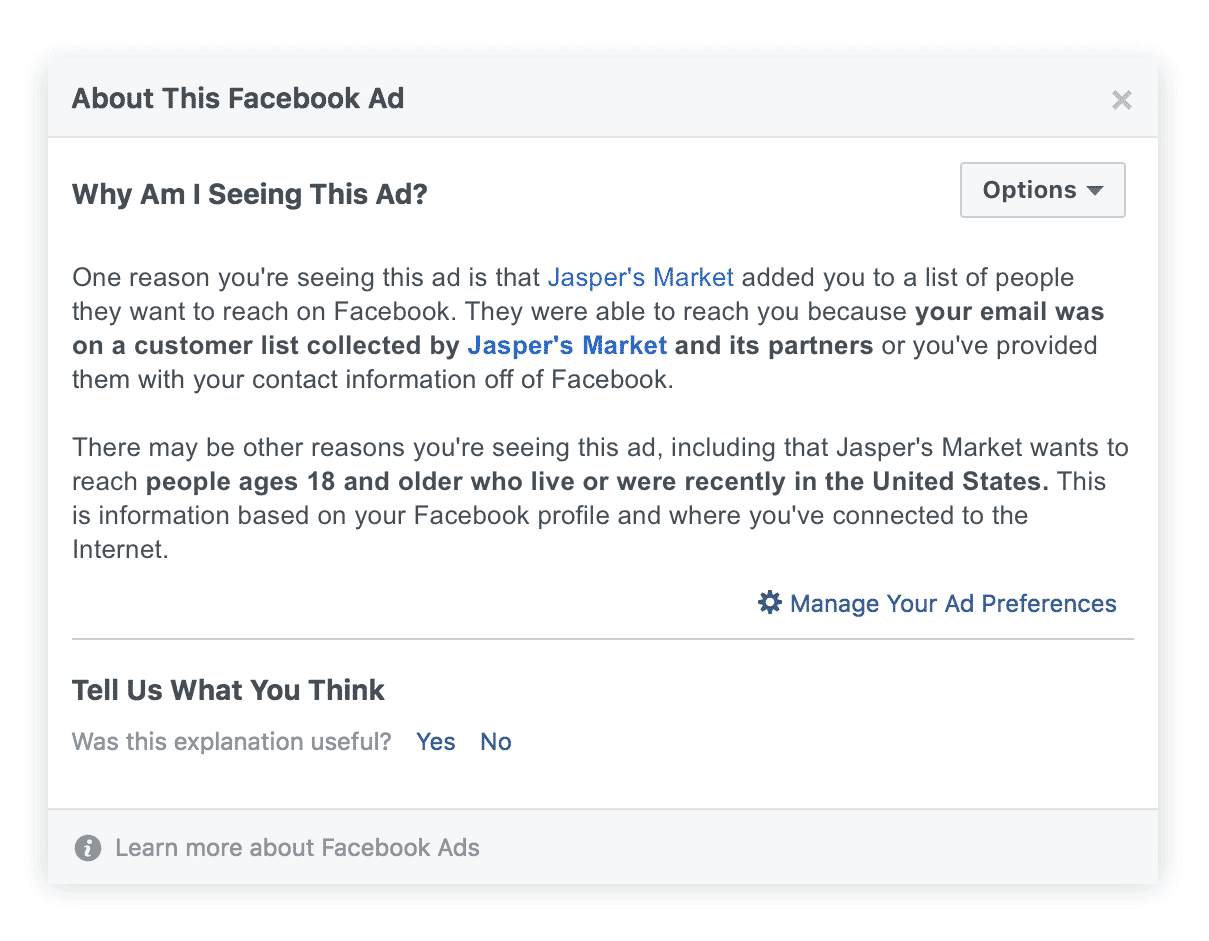
- Audience-sharing requirements: As of this update, sharing custom audiences must go through the Business Manager, along with explicit acceptance of Facebook’s custom audience terms.
- In-platform terms education: While it’s still the advertiser’s responsibility to understand the terms and conditions for using Facebook, the platform began featuring educational tips and resources to increase awareness of the policies.
August 3rd: Facebook down for 45 minutes
Facebook experienced approximately 45 minutes of global downtime, giving us all a peek into the true impact Facebook has on users’ content discovery habits. In those 45 minutes:
- Search engine traffic rose by 8%
- Global traffic increased by 2.3%
- Direct traffic increased by 11%
October: News Feed Demotes Sites with Stolen or Scraped Content
Similar in theme to Google’s Panda update back in 2011, Facebook is now demoting links to scraped or low-quality sites on the News Feed.
What’s most interesting about this update is that it’s a sort of one-two punch, coming on the heels of yet another data breach in September, which affected 50 million users. If any of those profiles were scraped and used in sites, Facebook would (theoretically) automatically demote the content, preventing it from ever appearing.
Facebook’s intention was to make stealing content less profitable, although this primarily focuses on organic traffic. It’s not clear how ads are affected.
So, how does Facebook determine if content is stolen?
We stole this explanation from TechCrunch, who broke the story:
Its systems compare the main text content of a page with all other text content to find potential matches. The degree of matching is used to predict that a site stole its content. It then uses a combined classifier merging this prediction with how clickbaity a site’s headlines are plus the quality and quantity of ads on the site.
November: “Borderline” Content to Receive Less Distribution
In order to improve user interaction with content, Facebook began its attempts to reverse the natural pattern of engagement, which rewards content the closer it gets to crossing the border into prohibited areas:
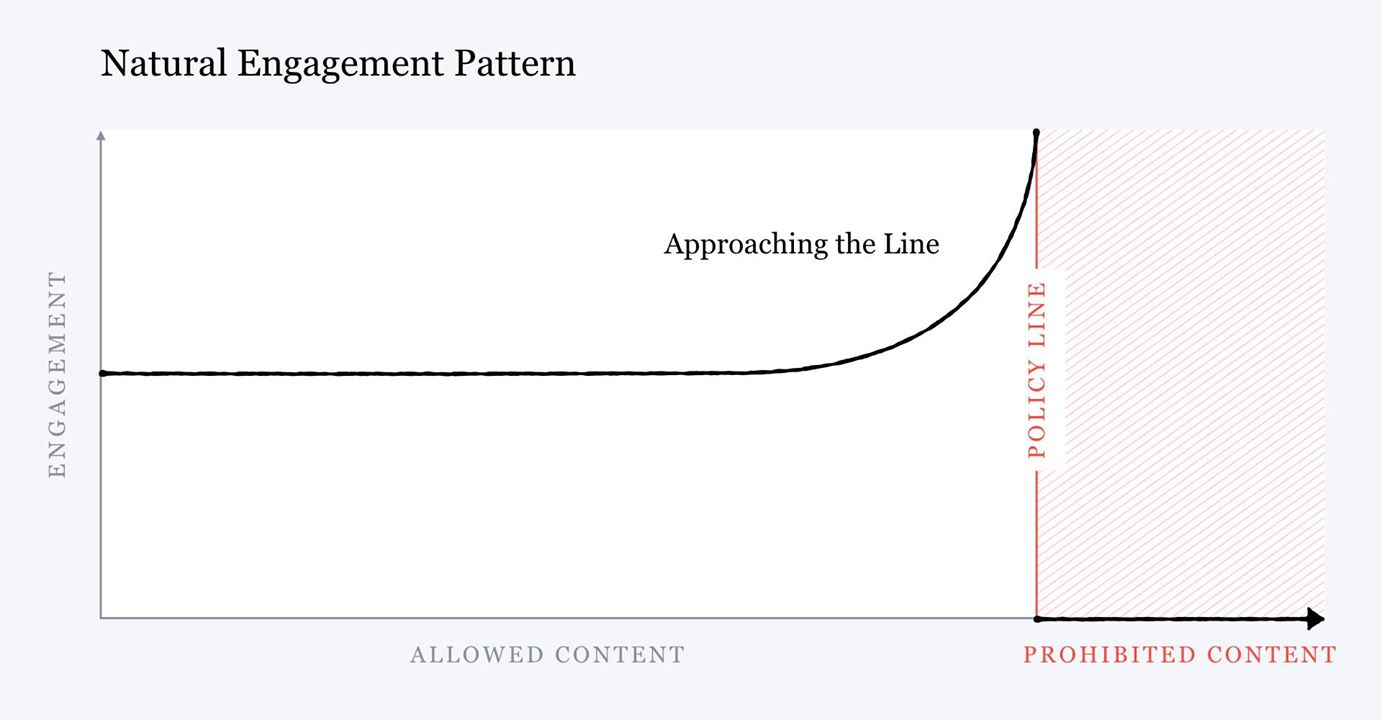
With this update, Facebook aims to reverse the upward trend in engagement, replacing it with demotion:

For affiliates, this has traditionally been the “sweet spot” – maximizing engagement but avoiding crossing the line and facing penalties.
Penalties to borderline content will affect not only the News Feed, but all site content – including Groups and Pages.
This isn’t the first time Facebook has tackled this issue. Starting in 2014, it downranked links with high bounce rates from people who didn’t “Like” the referring post. In 2016, Facebook began analyzing headlines for common clickbait phrases, and this year it banned “clickbait rings” for inauthentic behavior.
The update is new and still rolling out, so the verdict isn’t in yet… but if you’ve noticed certain angles working less effectively recently, it could be worth checking out the full post from Mark Zuckerberg.
November: Improving transparency in sharing the FB Pixel and Offline Event Sets
This updated followed the removal of Partner Categories and the changes to custom audience rules, adding new controls for sharing the Facebook pixel and offline event sets.
This is all about transparency and doesn’t impact ad serving directly. From Facebook:
In order to begin sharing pixel or offline event information with another business, you’ll need to define your business’ relationship with the business you want to share data with and review and reaffirm your compliance with our existing Business Tools Terms of Service.
Those businesses who have already shared their pixels prior to November have had to re-authenticate their shared assets.
December: Sexual Solicitation policy updated
New rules came into effect earlier this month regarding sexual solicitation in ads, tightening an already strict policy.
The new rules forbid:
- Pornography and other explicit sexual content (which was already banned)
- “Implicit sexual solicitation”, which includes the use of sexual slang and vague suggestive statements, such as “looking for a good time tonight?”
- The solicitation of nude images
- Discussion of sexual partner preference
Some claim that this will push innocent users off the platform, as even “Netflix and chill?” could be considered running afoul of the new rules.
December: Facebook sheds light on the content review process
After the New York Times attacked Facebook for what they called “ad hoc” policy-making, Facebook responded by clarifying their process for reviewing content and determining policies.
Here are the key takeaways:
- Policies are determined by “a global forum held every two weeks where we discuss potential changes to our policies. It includes experts from around the world with deep knowledge of relevant laws, online safety, counter-terrorism, operations, public policy, communications, product, and diversity.”
- Facebook has 30,000 employees focused on safety (both community guidelines and advertising policies). 15,000 of those employees are content reviewers.
- They reiterated their stance on hate speech in Myanmar, which caught a lot of attention throughout the year.
Summary of changes at Facebook in 2018
These have only been the main highlights; this was clearly a year of immense change at Facebook.
The biggest changes that you may have missed were:
- Removal of Partner Categories
- Info & Ads tab rollout
- Privacy and API changes
- “Borderline” content update
- Stolen or scraped content demotion
We suggest reading the updates carefully to ensure you’re still compliant; these updates undoubtedly contain the keys to understanding the account bans that have risen dramatically in recent months.
Of course, staying up to speed is a constant challenge. We’re just over a month into 2019 and Facebook has already posted 16 updates to the Newsroom – and sadly, very few are relevant to our industry, so it’s hard to keep on top of valuable lessons.
That’s why we tend to learn from each other in groups, forums and private discussions. However, going directly to the source on occasion can unlock valuable insights – and allow you to act on them faster than the majority.
Do you have thoughts about what Facebook will do in 2019? Let us know in the comments or reach out to your AM – we love discussing this stuff!
